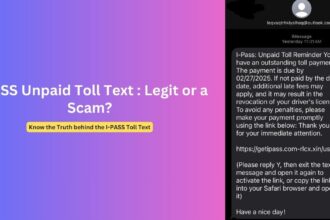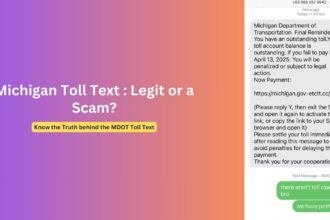In recent months, thousands of Americans have reported receiving unsolicited text messages from “CNFI USA” offering personal loans of up to $40,000. These messages often target financially vulnerable individuals, including those facing disability, job loss, or considering bankruptcy.
While the prospect of quick cash may seem appealing during difficult times, these unsolicited loan offers are part of a sophisticated phishing scam designed to steal personal information or trap victims in predatory financial arrangements. This article examines the CNFI USA loan scam, how it operates, and what you can do to protect yourself.
The Rising Tide of Loan Scam Texts
The Federal Trade Commission (FTC) has reported a 58% increase in loan and credit-related scams since 2022, with text messages becoming the preferred method for scammers. These operations have become increasingly sophisticated, using techniques that mimic legitimate financial institutions and targeting individuals based on data scraped from various sources.
The CNFI USA scam is part of a broader trend of unsolicited loan offers that have flooded mobile phones nationwide. These messages typically suggest pre-approval for substantial loans, often in the $40,000 range, and create a false sense of urgency or familiarity, with phrases like “checking in again” even if it’s the first contact.
“These scammers are leveraging the financial anxiety many Americans feel,” explains Maya Rodriguez, a cybersecurity analyst specializing in financial fraud. “They know that people facing economic hardship are more likely to respond to promises of easy money, making them perfect targets.”
Overview of the CNFI USA Loan Offer Scam: How It Works
The CNFI USA scam operates using a multi-stage approach designed to either harvest personal information or lure victims into predatory financial arrangements:
- Initial Contact: Victims receive unsolicited text messages offering pre-approved loans, often mentioning specific dollar amounts to appear legitimate.
- False Legitimacy: The texts use official-sounding company names like “CNFI USA” (which may sound like a legitimate financial institution) and create false familiarity by saying things like “checking in again” to make victims believe they previously expressed interest.
- Information Harvesting: If recipients respond or click on included links, they’re directed to sophisticated phishing websites that mimic legitimate loan application portals, where they’re asked to provide sensitive personal and financial information.
- Data Exploitation: The scammers then use this harvested information for identity theft, unauthorized credit applications, or selling the data to other criminal enterprises.
- Alternative Outcome: In some cases, rather than pure scams, these messages lead to predatory lenders offering real but extraordinarily unfavorable loan terms to financially vulnerable individuals.
One victim reported: “After losing my job, I was desperate and clicked on one of these loan offer links. Within days, multiple unauthorized credit applications appeared on my credit report, and my bank account was compromised.”
Common Text Patterns and Variations
The CNFI USA and similar loan scam texts follow recognizable patterns, though they constantly evolve to evade detection. Common elements include:
Message Structure:
- Personal greeting using the recipient’s first name
- Mention of a specific loan amount (commonly $40,000)
- Suggestion of previous contact (“checking in again”)
- Request for immediate action
- URL or phone number to “proceed with the application”
Typical Phrasing Examples:
Hi [First Name], CNFI USA checking in again regarding your personal loan options. Let me know if you no longer need $40,000, otherwise, do you have a few minutes to go over your options?
Your loan from [Company Name] is pending. Reply YES to receive approval status alerts via text.
Your request has been updated and more might be available [URL]. Reply Stop to OPTOUT
CNFI $40k Loan Update: [First Name] your submission status update [URL]
Sending Numbers:
These texts come from regular 10-digit phone numbers rather than official short codes used by legitimate financial institutions for bulk messaging. The numbers frequently change as they get reported and blocked.
Red Flags That Expose the CNFI USA Text as Fraudulent
Several telltale signs can help identify these messages as fraudulent:
1. Unsolicited Offers
Legitimate financial institutions don’t send unsolicited loan offers via text message, especially with pre-approved specific amounts. Banks and credit unions typically require you to apply first before discussing specific loan amounts.
2. Urgency and Pressure
Scam messages create false urgency with phrases like “checking in again” or suggesting a pending application that needs immediate attention. This pressure tactic aims to make recipients act before thinking critically.
3. Generic Company Names
Names like “CNFI USA” sound official but are deliberately vague. Legitimate financial institutions clearly identify themselves with their well-established brand names.
4. Regular Phone Numbers
Legitimate banks use registered short codes (5-6 digit numbers) for mass text messaging, not regular 10-digit phone numbers.
5. Poor Grammar and Formatting
While sophisticated scams have improved their writing, many still contain subtle grammar errors, unusual spacing, or formatting inconsistencies.
6. Suspicious URLs
Links in these messages often lead to recently created websites with domain names that slightly mimic legitimate financial institutions but contain additional words or slight misspellings.
7. Too Good To Be True
Offers of large loans without credit checks, income verification, or formal application processes are almost always scams.
Protecting Yourself from Fake CNFI USA Loan Offer Text
Taking proactive steps can help shield you from these scams and limit their impact:
Immediate Response to Suspicious Texts
- Do not click on links in unsolicited text messages
- Never reply with personal information
- Block and report the sending number
- Forward suspicious texts to SPAM (7726)
- Document the message for potential future reporting
Preventative Measures
- Freeze your credit reports with all three major bureaus (Experian, Equifax, and TransUnion)
- Enable two-factor authentication on all financial accounts
- Register your number on the National Do Not Call Registry (though scammers typically ignore this)
- Use data removal services like DeleteMe or Optery to reduce your digital footprint
- Install spam-blocking apps on your smartphone
Effective Response Template
One particularly effective response reported by victims is a formal message citing legal protections:
Unauthorized contact – This is an unsolicited text sent to a phone number on the National DNC Registry.
I have made no inquiry to your business and have not consented to any contact via this cellular number, including but not limited to text, calls, and automated dialing/texting technology.
“stop,” “quit,” “end,” “revoke,” “opt out,” “cancel,” “unsubscribe”
Please respond ONLY with:
– Where you obtained my phone number
– The contact information for your compliance and/or legal department
Without this information, I will file a TCPA complaint and demand payment.
Further attempts will be included in my demand.
Users report that this formal response typically results in immediate “unsubscription” from further messages.
The Broader Context: Predatory Targeting
What makes the CNFI USA and similar scams particularly insidious is their targeting methodology. Analysis of victim reports suggests these operations specifically target financially vulnerable individuals using data harvested from various sources.
“These scammers appear to have access to information about people’s financial situations,” notes consumer protection attorney Samantha Wilson. “They’re specifically targeting those who’ve recently experienced job loss, medical emergencies, or other financial hardships—people who might be desperate enough to consider high-interest loans.”
This targeting explains why some victims receive these messages shortly after experiencing financial difficulties, suggesting the scammers may purchase data from legitimate companies or access information from compromised databases.
Frequently Asked Questions
1. Is CNFI USA a legitimate financial institution?
No. CNFI USA does not appear to be a registered or licensed financial institution. Legitimate banks and lenders must be registered with state and federal regulatory authorities and will have verifiable physical addresses, phone numbers, and professional websites.
2. What should I do if I’ve already responded to a CNFI USA text?
If you’ve already clicked links or provided personal information, you should:
- Immediately freeze your credit with all three major credit bureaus
- Change passwords for all financial accounts
- Enable two-factor authentication where available
- Monitor your credit reports for unauthorized activity
- File reports with the FTC and your local police department
3. How did these scammers get my phone number and name?
Your information was likely obtained through:
- Data breaches of legitimate companies
- Data broker companies that compile and sell consumer information
- Public records and social media
- Previous scam responses that confirmed your number is active
4. Can I take legal action against these scammers?
While legal options exist under the Telephone Consumer Protection Act (TCPA), pursuing scammers is challenging as they often operate overseas or use sophisticated methods to hide their identities. However, reporting to the FTC, CFPB, and your state attorney general can help authorities take broader action against these operations.
5. Are there any legitimate loan offers sent via text message?
Legitimate financial institutions rarely initiate loan offers via unsolicited text messages. If you have an existing relationship with a bank, they might text you about pre-qualified offers, but these will direct you to log in to your secure account portal rather than clicking external links. When in doubt, contact your financial institution directly using their official phone number.
Conclusion: Vigilance as the Best Defense
The CNFI USA loan scam represents just one variant in the expanding ecosystem of financial fraud targeting vulnerable Americans. As economic uncertainties persist, these scams will likely continue to evolve in sophistication and scale.
The most effective defense remains vigilance and skepticism toward unsolicited financial offers, particularly those received via text message. By understanding the patterns and warning signs outlined in this article, consumers can better protect themselves against these predatory tactics.
Remember that legitimate financial assistance options exist for those facing hardship, including nonprofit credit counseling services, community assistance programs, and regulated financial institutions. These legitimate resources never require upfront fees or personal information via unsecured channels before providing assistance.
If you’ve received suspicious loan offer texts, report them to the Federal Trade Commission at ReportFraud.ftc.gov and to your state’s attorney general’s office. These reports help authorities track and ultimately take action against the organizations behind these fraudulent operations.
This article was researched and written based on victim reports, cybersecurity expert interviews, and FTC data. If you’ve been targeted by the CNFI USA scam or similar operations, please report it to the appropriate authorities.









































